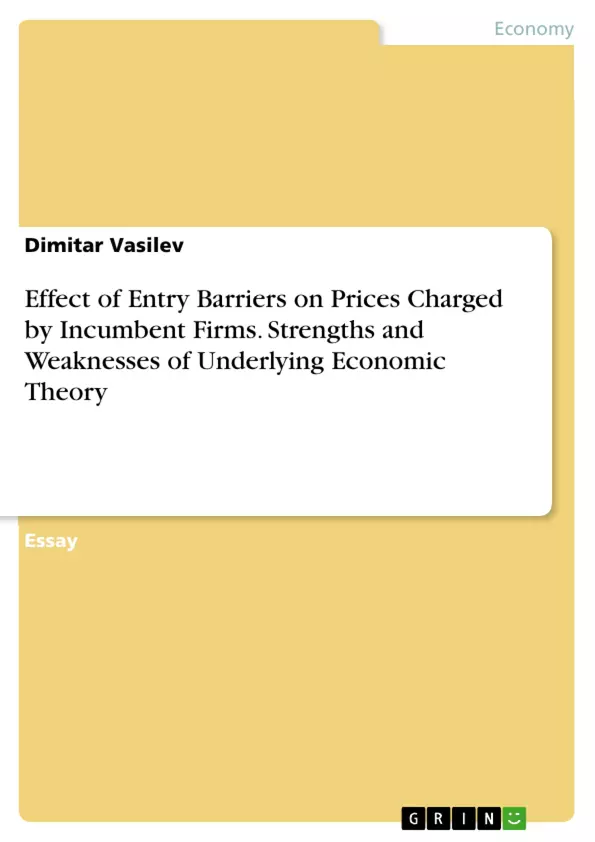Entry prevention in imperfectly contestable industrial markets has been topic of extensive interest among academics. This paper seeks to explain effects of entry barriers on incumbent firms’ pricing decisions. Underlying economic theory is critically assessed, evaluating credibility of strategic pricing behavior models in the context of real-life business environment.
Inhaltsverzeichnis (Table of Contents)
- Introduction
- Barriers to Entry
- Structural Barriers to Entry
- Strategic Barriers to Entry
- Limit pricing
- Predatory Pricing
- Excess Capacity
- Conclusion
Zielsetzung und Themenschwerpunkte (Objectives and Key Themes)
This paper aims to analyze the impact of entry barriers on the pricing decisions of incumbent firms in imperfectly contestable markets. The paper critically evaluates the underlying economic theory and explores the credibility of strategic pricing models in real-world business environments.
- Effects of entry barriers on incumbent firms' pricing strategies
- Assessment of strategic pricing behavior models in the context of real-world business environments
- Distinction between structural and strategic barriers to entry and their respective implications for price setting
- Analysis of entry-deterring strategies such as limit pricing, predatory pricing, and excess capacity
- Evaluation of the strengths and weaknesses of underlying economic theory, including game theoretical models.
Zusammenfassung der Kapitel (Chapter Summaries)
- Introduction: This chapter introduces the concept of market entry and distinguishes between different types of entrants. It highlights the significance of entry barriers in hindering the shift towards a more competitive market and introduces the distinction between structural and strategic barriers to entry.
- Barriers to Entry: This chapter defines entry barriers as factors that allow incumbent firms to maintain positive economic profits while discouraging new entrants. It examines both structural and strategic barriers to entry, outlining the different mechanisms by which each type of barrier affects incumbent firms' pricing decisions.
- Structural Barriers to Entry: This section discusses specific examples of structural barriers, including control of resources, economies of scale and scope, marketing advantages, and direct sunk cost investments. It explains how these factors can create strategic assets for incumbent firms, potentially leading to a blockaded entry scenario where the incumbent retains a monopoly position.
- Strategic Barriers to Entry: This section delves into strategic corporate behavior designed to deter entry by potential competitors. It explores the underlying assumptions of strategic barriers and presents three key entry-deterring strategies: limit pricing, predatory pricing, and excess capacity.
- Limit pricing: This section focuses on the limit pricing model, which involves setting prices low enough to discourage potential entrants. It utilizes a game theoretical model to illustrate the price effects of limit pricing on incumbent firms and analyzes the strengths and limitations of this strategy.
- Predatory Pricing: This section examines predatory pricing, a strategy where incumbent firms manipulate prices to drive out existing competitors. It explores the “deep pocket” concept and reputation signaling models, highlighting the complexities and potential ineffectiveness of this strategy in certain scenarios.
- Excess Capacity: This section discusses the use of excess capacity as a strategic barrier to entry. It explains how building excess capacity can allow incumbent firms to deter entry by increasing output at low cost and lowering prices, ultimately reducing profit margins for potential competitors.
Schlüsselwörter (Keywords)
The central concepts and terms explored in this paper include: entry barriers, incumbent firms, strategic pricing, limit pricing, predatory pricing, excess capacity, imperfectly contestable markets, game theoretical models, economic profits, and market share.
- Arbeit zitieren
- Dimitar Vasilev (Autor:in), 2011, Effect of Entry Barriers on Prices Charged by Incumbent Firms. Strengths and Weaknesses of Underlying Economic Theory, München, GRIN Verlag, https://www.hausarbeiten.de/document/180767


